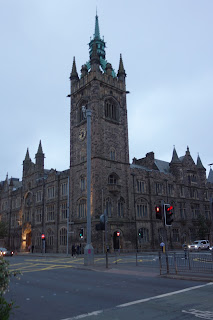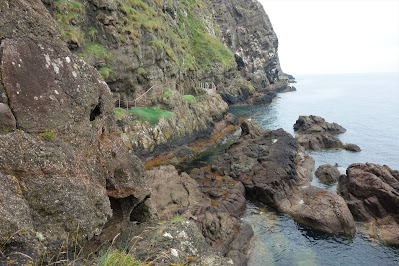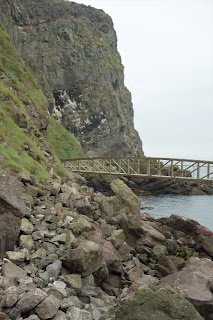Northern Ireland is a part of the United Kingdom in the north-east of the island of Ireland that is variously described as a country, province or region. Northern Ireland shares an open border to the south and west with the Republic of Ireland. In 2021, its population was 1,903,100, making up about 27% of Ireland's population and about 3% of the UK's population. (This is according to Wikipedia.) Our brief travel through the north part of Ireland was seamless in terms of any political divisions that exist therein. Nevertheless, my limited knowledge and understanding of the complex issues surrounding the "Potato Famine" and the "Troubles", did shed light on some of the artwork, graffiti, and spoken sentiments of people heard throughout our 2-weeks of travel around the beautiful island.
Our introduction to Northern Ireland came from a self-guided tour of Dunluce Castle ruins. The medieval castle had it's beginnings in the 13th century. Even the ruins exhibit what must have been the grandeur of the place. And there couldn't be a more beautiful coastline location!

I was excited for our next stop, the intriguing Giant's Causeway adds an additional artistic form to mother nature's extensive portfolio. A rainstorm fell on us as we hiked the upper trail, but it didn't deter us from enjoying the remainder of the hike. This UNESCO World Heritage Site is an area of about 40,000 basalt columns that were formed by a volcanic eruption. The tops of the columns form hexagonal shaped stepping-stones that disappear into the sea. The legend is that this causeway was formed as the result of a fight between an Irish giant and a Scottish giant. The giant's foot (rock) can be seen in one of the photos below. Other notable features are the tall organ pipes, and the chimney stack on a cliff in the distance.

From the Giant's Causeway, the next stop on our way to Dublin, on Thursday, September 9, 2021, was a tourist site made famous by it's appearance in the HBO series, "Game of Thrones". This beautiful avenue of beech trees was planted by the Stuart family in the eighteenth century as an impressive approach to the entrance of their Georgian mansion, Gracehill House.
We drove through one of the oldest cities in all of Ireland, Carrickfergus, which became an inhabited town shortly after 1170, when Anglo-Norman knight John de Courcy invaded Ulster and built Carrickfergus Castle. The castle, is known as one of the best-preserved Norman castles in Ireland. A short walk around the town took us to St. Nicholas's Church where I admired the Celtic Cross Tombstones. I like the idea that the circle around the cross represents the celestial sphere.




It was evening when we drove into Belfast and checked into our hotel. An evening stroll gave us a glimpse of some of Belfast's architecture, and abundance of international cuisine. We filled our stomachs with Chinese food before drifting off to sleep that night. One thing I remember finding funny were the tiny bottles of Coke, which we were served in Belfast. I even saved two of them to bring home and place fresh cut flowers in - and yes, the waiter thought I was a bit crazy for doing so. I had to explain to him that we were from Texas - where everything is BIG.
In the morning we drove to Islandmagee, just north of Belfast to do The Gobbins Walk. The Gobbins is a cliff-face path in Northern Ireland's Coastal Causeway, which runs across bridges, past caves and through a tunnel. The cliffs are recognized for their rich birdlife and important geology. The walkway was created by an Irish railway engineer named Berkeley Deane Wise. He designed and built the path as a tourist attraction for the Belfast and Northern Counties Railway Company. The path first opened to the public in 1902, and has been described as having a beauty that baffles all description. To walk the Gobbins was another one of the things I was most excited to do while in Ireland, and it was an incredible experience (though not as challenging or scary as I had anticipated).

Having some time to spare that afternoon, we decided to go to the Titanic Museum in Belfast. It ended up being much more interesting than I had imagined. The impressive museum is built on the very spot that the Titanic was constructed. And it is the only museum which we have visited that includes an informational roller coaster ride inside!
From Belfast, we drove about one and a half hours to the Drogheda area where we called it a day.



















































































.JPG)

No comments:
Post a Comment